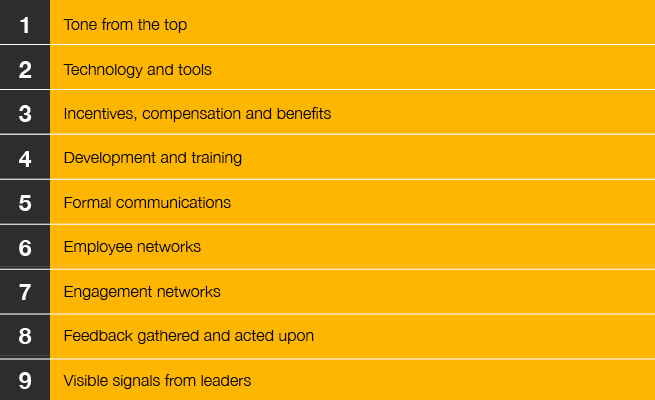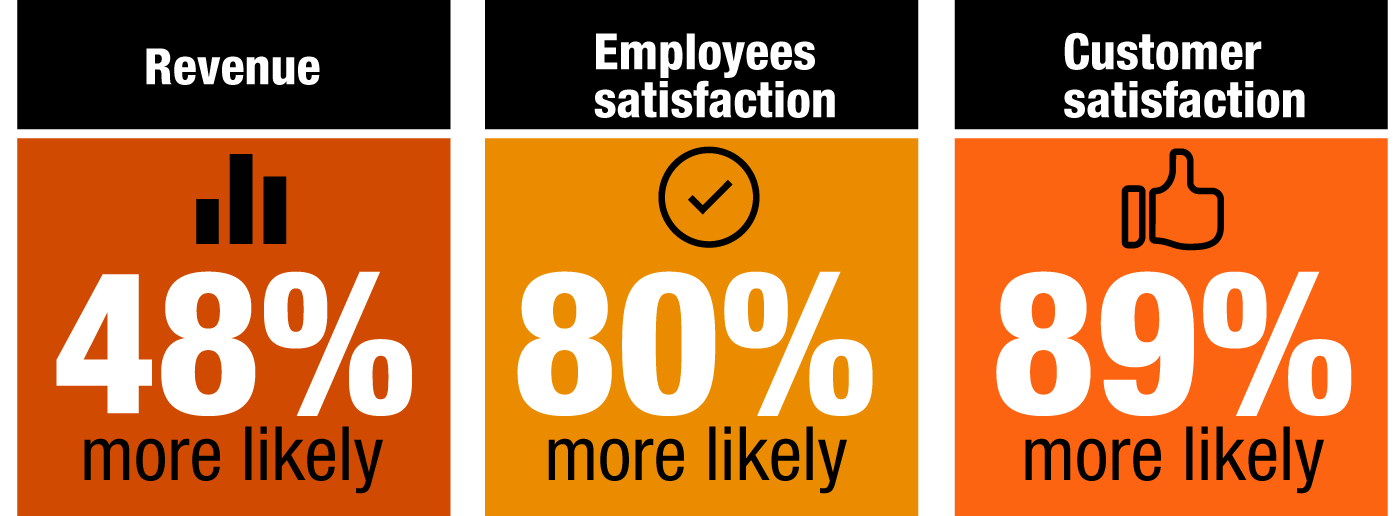If you do a quick search, you will easily find a multitude of definitions of the word culture, depending on the context. For the purpose of this blog, let’s go with the one from the Merriam-Webster dictionary that says culture is “the set of shared attitudes, values, goals, and practices that characterises an institution or organisation”. That rather straight-to-the-point definition depicts what corporate culture is in a nutshell.
A corporate culture—or organisational culture—is airborne. It is normally reflected in the dress code, business hours, office setup, employee benefits, turnover, hiring decisions, among others. In sum, it stems from how a company’s employees and leaders behave and interact with each other and with all stakeholders. Moreover, it’s not usually explicitly defined, but rather implied, and developed organically over time from the aggregated traits of the people the company hires.
On a scale from zero to 10, how much weight does a company’s culture have on your decision to accept a job offer? We will take a wild guess and say that even though it’s an important aspect, it’s not a crucial one. Despite being a generation whose expectations in the workplace are values-driven, a study found that 54% of Gen Z job seekers acknowledge that pay is their number one priority when it comes to a first job. In another study, 58% of Gen-Z workers said they were willing to work nights and weekends if it meant achieving a higher income.
But the truth is no one enjoys getting an urgent email or phone call from their manager late at night or during the weekend asking to make changes to a report for a client, or being on holidays and having to deal with something pressing that, apparently, only they can handle. Or even yet, having to continuously work for long hours because the company isn’t—or is having trouble —hiring people. In fact, these are the kinds tihs of situations that often lead people to eventually quit their jobs.
The irony is that, meanwhile, certain leaders who make such demands tend to emphasise the importance of well-being and encourage their people to take time off to recharge. It begs the question: how can you trust someone who isn’t consequent, who says one thing but does the opposite?
As paradoxical as it might be, many business leaders see organisational culture as a powerful ally. So much so that 67% of board and C-suite participants in PwC’s 2021 Global Culture Survey say culture is more important to performance than the strategy or the operating model. Yet, as we will delve into it later on, they don’t seem to turn words into action.
This article deep dives into the major obstacle to tapping culture’s full potential, that is, employee’s lack of trust towards leadership, and the key actions leaders can take to activate a legitimate corporate culture and gain competitive advantage.
Leaders’ words vs employees’ experiences
The reason why many employees don’t trust their leaders simply comes down to a matter of inconsistency. First, some leaders don’t act authentically—their behaviour is at odds with the cultural message they’re sending. Second, in many organisations, the professed culture doesn’t match employees’ expectations and experiences. That’s the opposite of what being trustworthy means.
Both issues could be leading to an iminent talent retention crisis. During the pandemic, people were “sheltering in job”, that is, they stayed in their jobs because they feared the labour market instability. But now, people are quitting their positions in high numbers. In Luxembourg, for instance, turnover in services went from a record low of -21.5% year-on-year in June 2020 to a record high of 36% year-on-year in June 2021 (Source: Trading Economics).
Moreover, a global Microsoft study found that 41% of workers are considering quitting their job or changing their profession this year. Some economists have dubbed this phenomenon the ‘Great Resignation’. The reasons behind it are varied. For instance, some workers were propelled by the pandemic to pursue their “dream job” or to become a stay-at-home parent. However, for many others, the decision to leave was driven by how their employer treated them during the pandemic.
But PwC’s Culture survey shows that leaders should prioritise culture in the face of this and many other challenges. Those respondents who said their organisations have a distinctive culture were more likely to report good outcomes during the first year of the pandemic (see graphic below).
Note: Data shown is based on 1,986 respondents who said they “agree” or “strongly agree” that the organisation they work for has a distinctive culture.
Source: PwC, 2021 Global Culture Survey
The reality is that if leaders want culture to be a source of competitive advantage and to help them build trust with their employees, their hopes about it and employees’ experiences with it need to align. You may have guessed the sentence that follows: this isn’t always the case.
Going back to our latest Global Culture Survey, 79% of C-suite and board respondents agreed or strongly agreed that what they say about their culture aligns with the way people act every day in their organisation—but only 58% of frontline workers shared the same view.
Diversity and inclusion misalignment
The contrast is particularly blunt when it comes to diversity, equity and inclusion, with 64% of C-suite and board respondents saying that their organisation encourages discussion of sensitive and uncomfortable topics, but only 51% of frontline workers agreeing with that. And 71% of C-suite and board members said their organisation embraces flexibility and accommodates people with different needs, while only 54% of frontline workers said the same.
Additionally, the survey shows that 73% of senior management think they lead by example on culture. But only 46% of the rest of the workforce agree.
This mismatch surely damages trust. As a consequence, it can be difficult to motivate people and encourage the desired behaviours. Now, to close these gaps, leaders will need to clearly understand the impact of leadership authenticity and cultural cohesion and develop an action plan for activating their culture.
Authentic leadership and organisational coherence: what does it mean?
While there are different angles for what authentic leadership entails, there are some traits which are mostly agreed upon. Authentic leaders should be self-aware, genuine, lead with their hearts and focus on the long-term.
A very concrete example of authentic leadership was when, at the beginning of the pandemic, New Zealand’s prime minister, Jacinda Ardern, hosted a Facebook Live from her home to explain to her constituents the importance of imposing a national lockdown. Her message was clear: what she was asking of them also applied to her. No exceptions.
Another important aspect is cultural coherence in terms of the actions of the organisation as an entity. According to Glassdoor—an influential website for anonymous companies review— HubSpot, which has won awards for its culture, is a good example of this. The company has focused on inclusion and being mission-focused, and has taken steps to make sure that it is coherent in not just talking about these matters but practicing them.
Turning a consistent culture into reality
By now, it’s clear that the current mismatch between what leaders and organisations advocate about culture and what employees experience is an obstacle to achieving strategic objectives such as improving recruitment and retention and building trust. It’s time to look into solutions. According to the authors of a strategy+business article that dives into this matter, on which this blog entry is based, there are three actions leaders can take to activate culture and gain competitive advantage.
1. Measure the impact of culture on strategic goals
It doesn’t cost anything just to ask, does it? When looking to build a strong organisational culture, feedback and data analysis are allies. People surveys, cultural-focus diagnostics, employee experience assessments, focus groups, one-to-one interviews, get observations from influential people (the so-called authentic informal leaders or AILs), all of them are helpful. And when working in tandem they can bring even more insight into the corporate culture to determine if culture is aligned with strategy and to define the drivers of experience that matter the most to employees.
Leaders can take an active role to gather regular feedback by asking how their organisation’s culture is helping or hindering their ability to drive business outcomes. They can also identify any areas of incoherence between stated cultural aspirations and employees’ day-to-day experiences.
2. Focus on the cultural characteristics and behaviours that support business goals.
Why do people in the organisation behave in certain ways? Hierarchy, consensus for decision making, approach to teamwork, how success or failure are lived, conflict handling, job performance, time organisation…an inventory of these “ways of being” help to understand culture. However, it’s important to move decisively from understanding the behaviours that are present in an organisation’s culture to prioritising those that will be most helpful in meeting business goals.
And once that happens, a balancing act is necessary because the organisation should make key decisions to select the critical behaviors and characteristics their culture will stand for and live by. And leaders’ implication, assessment and decision when running this trade-off exercise is fundamental.
For instance, an organisation might need to balance being customer-centric with maintaining an environment where employees feel cared for and don’t get burned out.
Or an agile, high-performing organisation might need to avoid alienating or marginalising people with different perspectives, backgrounds, or capabilities.
3. Carry it forward with cultural change enablers
The last step is to make sure your culture is lined up across the entire organisation’s system.
When leaders actively manage culture, people will naturally lean towards the critical behaviours that drive business success. But what does this mean in practice?
They will need to, among others, set the right tone from the top, acquire the necessary technology and tools to uphold change, and not only collect but also act on employees’ feedback. These examples of enablers can effectively help organisations create the consistency around the attributes and behaviours leaders have established as most decisive.
Setting the right tone from top and evident leadership encouragement are the two enablers directly linked to leadership authenticity. To achieve such authenticity, leaders will need to leave their secluded offices and see with their own eyes the daily realities experienced by employees. Only then, they will understand the full extent of their management decisions and the implications they bring. It’s true that “management by walking around” is more challenging when employees work from home, but there are always workarounds as the pandemic showed us again and again.
Culture as a source of competitive advantage
Culture is an essential part of our lives. We need them as individuals, as a society and as an organisation.
However organisational culture is one of those matters that are easier to name and mention than to live and feel. To truly materialise it, the call for moving from rhetoric to action is constant, like an infrared siren’s call. PwC’s 2021 Global Culture Survey shows that culture can deliver competitive advantage and that’s particularly important during challenging times like the ones the entire globe has been living during the last 18 months or so.
Alignment takes one second to be spelled but a conscious, permanent work to get business strategy, purpose, operating model and culture interlinked takes much more time and effort. But it pays off. Trust, employee retention, risk mitigation and reputation, they all turn green when calculating the bottom line.



